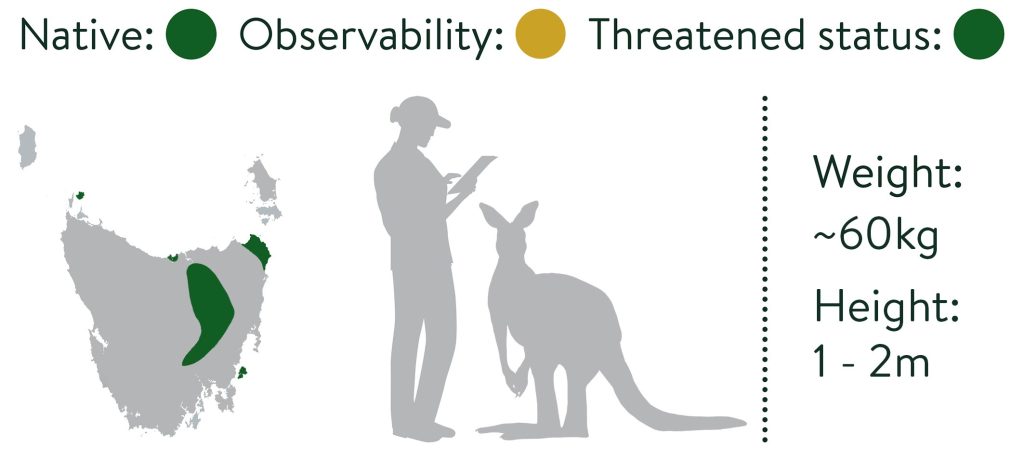Macropodidae | Macropus giganteus
The forester kangaroo stands tall as the largest land mammal in Tasmania and the most broadly distributed macropod (big foot) in Australia. Kangaroos are much more common on the mainland where this species is known as the eastern grey.

Lifestyle
Preferring to forage in the early morning and late afternoon, these kangaroos often form groups of around 6-10 individuals, primarily comprised of female relatives. In more abundant habitats, they may assemble into larger foraging ‘mobs’ by congregating with other groups. Females tend to establish stable territories and live in one location throughout their lives, while males, driven by the pursuit of females and territory, venture further.
Male forester kangaroos, displaying ‘extreme sexual dimorphism,’ stand out in their larger size and muscular build, reaching up to two meters tall and weighing around 60 kg—sometimes twice the weight of females. Dominance among males is asserted through behaviors such as standing upright on their tippy toes and tails. In cases of similar height, they will often defer to wrestling and kicking.
Breeding occurs year-round, with most births taking place between January and March. Pouch young become young-at-foot at about eleven months but won’t be fully weaned for a further six months or so.

Key identifying features
Largest native land mammal in Tasmania, second largest in Australia. Known as the Eastern grey kangaroo elsewhere in Australia. Males (1) are much larger and more muscular than females (2) but both sexes have a stockier build than other Tasmanian macropods. Thick tail, often darkening in colour along its length to a black tip (3). Large ears that sit high on the head (4) and a broad muzzle. Light brown-grey coat, pale grey underbelly. Females are greyer than males. Will graze in open environments.
Similar species
Bennett’s wallaby – smaller body and ears; tail is not as thick; black markings on nose and tips of the ears; white markings down the side of the face; coat is more red-brown and less uniform in colour.
Habitats
Forester kangaroos inhabit a variety of environments, including open forests, woodlands, shrublands, grasslands, and agricultural areas. Despite a significant reduction in their range across Australia since European colonisation, they can still be found in locally abundant populations.
Diet
Being primarily grazers, forester kangaroos favour native grasses, constituting up to 99% of their diet.
Threats
Foresters are threatened by habitat loss and hunting pressure, both historically and through crop protection permits.
